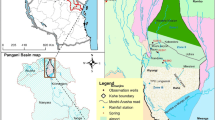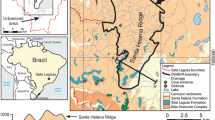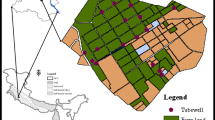Abstract
The objective of this study is to assess the groundwater recharge in the Makutupora basin, Central Tanzania using the soil moisture balance (SMB) and chloride mass balance (CMB) methods. The SMB method considered the estimation of both evapotranspiration in CROPWAT 8.0 software and surface runoff by the curve number (CN) method. The CN of the basin was determined based on hydrological soil group (HSG), antecedent moisture condition (AMC) and land use type using Arc GIS 10.2. Distributed land-use maps, slope and soil texture maps, daily climatological data (e.g., precipitation, temperature, wind speed, etc.), chloride concentration in rainfall and groundwater are the basic data used in this study. Input data were prepared in the form of digital maps using GIS and remote sensing tools and finally excel models were created to compute recharge using a set of given conditions. The results indicate that the average chloride concentration measured in the groundwater samples of the study area is 282.88 mg/L; much higher than the average concentration in rainwater samples which is 3.47mg/L while the average potential evapotranspiration is 2280 mm/year with an average rainfall of 680mm/year. Runoff computed using the CN method is ranging from 7.6–246mm/year or 0.68–22%. The final recharge from SMB is ranging from 0.025–117.86mm/year or 0.006–10% of annual rainfall equivalent to an average annual volume of 41.58Mm3 while recharge from CMB ranges from 2.57–44.6mm/year or 0.38–6.56% of annual rainfall equivalent to an average annual volume of 23.85Mm3. The results show that CMB underestimated the recharge compared to the SMB method. The reason for this is thought to be caused by the high chloride concentration analysed in groundwater compared to rainfall samples which may be caused by increased chloride concentration as water passes through the rock formations (unsaturated zone) to the saturated zone. Further lack of atmospheric chloride deposition data may be another contributing factor.
Similar content being viewed by others
References
Ali Rahmani, S.E., Chibane, B. and Boucefiène, A. (2017) Groundwater recharge estimation in semi-arid zone: a study case from the region of Djelfa (Algeria). Appl. Water Sci., v.7(5), pp.2255–2265. doi:https://doi.org/10.1007/s13201-016-0399-y
Allen, R.G., Pereira, L.S., Raes, D. and Smith, M. (1998) FAO Irrigation and Drainage Paper No. 56 — Crop Evapotranspiration. January 1998.
Aouragh, M.H., Essahlaoui, A., El Ouali, A., El Hmaidi, A. and Kamel, S. (2017) Groundwater potential of Middle Atlas plateaus, Morocco, using the fuzzy logic approach, GIS and remote sensing. Geomatics, Natural Hazards and Risk, v.8(2), pp.194–206. doi:https://doi.org/10.1080/19475705.2016.1181676
Arshad, A., Zhang, Z., Zhang, W. and Dilawar, A. (2020) Mapping favourable groundwater potential recharge zones using a GIS-based analytical hierarchical process and probability frequency ratio model: A case study from an agro-urban region of Pakistan. Geosci. Front., v.11(5), pp.1805–1819. doi:https://doi.org/10.1016/j.gsf.2019.12.013
Bakundukize, C., van Camp, M. and Walraevens, K. (2011). Estimation of Groundwater Recharge in Bugesera Region (Burundi) using Soil Moisture Budget Approach. Geologica Belgica, v.14(1–2), pp.85–102.
Cooper, C.A., Hershey, R.L., Healey, J.M. and Lyles, B.F. (2013) Estimation of Groundwater Recharge at Pahute Mesa using the Chloride Mass-Balance Method.
Corbari, C., Ravazzani, G., Galvagno, M., Cremonese, E. and Mancini, M. (2017) Assessing Crop Coefficients for Natural Vegetated Areas Using Satellite Data and Eddy Covariance Stations. doi:https://doi.org/10.3390/s17112664
Crosbie, R., Jolly, I., Leaney, F., Petheram, C. and Wohling, D. (2010) Review of Australian Groundwater Recharge Studies. CSIRO: Water for a Healthy Country National Research Flagship. www.csiro.au/org/HealthyCountry.html
Demlie, M. (2015a) Assessment and estimation of groundwater recharge for a catchment located in a highland tropical climate in central Ethiopia using catchment soil-water balance (SWB) and chloride mass balance (CMB) techniques. Environ. Earth Sci., v.74(2), pp.1137–1150. doi:https://doi.org/10.1007/s12665-015-4099-y
Demlie, M. (2015b) Assessment and estimation of groundwater recharge for a catchment located in a highland tropical climate in central Ethiopia using catchment soil-water balance (SWB) and chloride mass balance (CMB) techniques. doi:https://doi.org/10.1007/s12665-015-4099-y
DUWASA (2015) Dodoma Urban Water Supply and Sewerage Authority. URL www.duwasa.or.tz/about (accessed 5.12.2021)
DUWASA (2016) Dodoma Urban Water Supply and Sewerage Authority. URL www.duwasa.or.tz/about (accessed 31.12.2021).
Eriksson, E. and Khunakasem, V. (1969) Chloride concentration in groundwater, recharge rate and rate of deposition of chloride in the Israel Coastal Plain. Jour. Hydrol., v.7(2), pp.178–197. doi:https://doi.org/10.1016/0022-1694(69)90055-9
Ferede, M., Haile, A. T., Walker, D., Gowing, J. and Parkin, G. (2020) Multi-method groundwater recharge estimation at Eshito micro-watershed, Rift Valley Basin in Ethiopia. Hydrolog. Sci. Jour., v.65(9), pp.1596–1605. doi:https://doi.org/10.1080/02626667.2020.1762887
Guan, H., Love, A.J., Simmons, C.T., Makhnin, O. and Kayaalp, A.S. (2010) Factors influencing chloride deposition in a coastal hilly area and application to chloride deposition mapping. Hydrol. Earth Syst. Sci., 14(5), 801–813. doi:https://doi.org/10.5194/hess-14-801-2010
Hájková, L., Bartošová, L. and Konarová, V. (2018) Evaluation of aridity index in the Czech Republic within 1961–2015. Acta Universitatis Agriculturae et Silviculturae Mendelianae Brunensis, v.66(5), pp.1111–1118. doi:https://doi.org/10.11118/actaun201866051111
Jena, S.K., Tiwari, K.N., Pandey, A. and Mishra, S.K. (2012) RS and Geographical Information System-Based Evaluation of Distributed and Composite Curve Number Techniques. Jour. Hydrol. Engg., v.17(11), pp.1278–1286. doi:https://doi.org/10.1061/(ASCE)he.1943-5584.0000651
Kashaigili, J.J., Mashauri, D.A. and Abdo, G. (2003) Groundwater management by using mathematical modeling: the case of the Makutupora groundwater basin in Dodoma Tanzania. Botswana Jour. Tech., v.12(1), pp.19–24. doi:https://doi.org/10.4314/bjt.v12i1.15342
Kashaigili, Japhet J. (2010) Assessment of groundwater availability and its current and potential use and impacts in Tanzania. Report Prepared for the International Water Management Institute (IWMI). Sokoine University of Agriculture, Morogoro, Tanzania, December, pp.58.
Kumar, C.P. (1993) Estimation of groundwater recharge using soil moisture balance approach. 247667.
Kumar, C.P. (2003) Estimation of Ground Water Recharge Using Soil Moisture Balance Approach. Jour. Soil.Water Conserv., Soil Conserv. Soc. India, v.2(1 & 2), pp.53–58. http://www.angelfire.com/nh/cpkumar/publication/Smbp.pdf
Lorentz, S.A., Hughes, G.O. and Schulze, R.E. (2003) Techniques for Estimating Groundwater Recharge at Different Scales in Southern Africa. In: Groundwater Recharge Estimation in Southern Africa, v.64(1).
Lwimbo, Z.D., Komakech, H.C. and Muzuka, A.N.N. (2019) Estimating groundwater recharge on the southern slope of Mount Kilimanjaro, Tanzania. Environ. Earth Sci., v.78(24). doi:https://doi.org/10.1007/s12665-019-8690-5
Maréchal, J.C., Dewandel, B., Ahmed, S., Galeazzi, L. and Zaidi, F.K. (2006) Combined estimation of specific yield and natural recharge in a semiarid groundwater basin with irrigated agriculture. Jour. Hydrol., v.329(1–2), pp.281–293. doi:https://doi.org/10.1016/j.jhydrol.2006.02.022
Merem, E.C., Yerramilli, S., Twumasi, Y.A., Wesley, J.M., Robinson, B. and Richardson, C. (2011) The applications of GIS in the analysis of the impacts of human activities on South Texas Watersheds. Internat. Jour. Environ. Res. Public Health, v.8(6), pp.2418–2446. doi:https://doi.org/10.3390/ijerph8062418
Naranjo, G., et al. (2015) Estimating natural recharge by means of Chloride Mass Balance in a volcanic aquifer: Northeastern Gran Canaria (Canary Islands, Spain). Water, v.7, pp.2555–2574. doi:https://doi.org/10.3390/w7062555
Nkotagu, H. (1996) The groundwater geochemistry in a semi-arid, fractured crystalline basement area of Dodoma, Tanzania. Jour. African Earth Sci., v.23(4), pp.593–605. doi:https://doi.org/10.1016/S0899-5362(97)00021-3
Nugroho, A.R., Tamagawa, I., Riandraswari, A. and Febrianti, T. (2019) Thornthwaite-Mather water balance analysis in Tambakbayan watershed, Yogyakarta, Indonesia. 5007.
Onodera, S., Fellowship, T.A. and Danchi, T.K. (1993) Estimation of a rapid recharge mechanism in the semi-arid upland. IAHS Publ. v.215, pp.151–160. (Proceedings of the Yokohama Symposium).
Prasanna, P.R. (2015) Earth Science: GIS Based SCS — CN Method For Estimating Runoff in Kundahpalam Watershed, Nilgiris District, Tamil Nadu. Earth Sci. Res. Jour., v.19(1), pp.59–64 doi:https://doi.org/10.15446/esrj.v19n1.44714.
Rivard, C., Lefebvre, R. and Paradis, D. (2014) Regional recharge estimation using multiple methods: An application in the Annapolis Valley, Nova Scotia (Canada). Environ. Earth Sci., v.71(3), pp.1389–1408. doi:https://doi.org/10.1007/s12665-013-2545-2
Rwebugisa, R.A. (2008). Groundwater recharge assessment in the makutupora basin, Dodoma, Tanzania. Masterarbeit Am International Institute for Geo-Information Science and Earth Observation, Enschede, MSc Dissertation.
Scanlon, B.R., Healy, R.W. and Cook, P.G. (2002) Choosing appropriate techniques for quantifying groundwater recharge. Hydrogeol. Jour., v.10(1), pp.18–39. doi:https://doi.org/10.1007/s10040-001-0176-2
Scanlon, B.R., Keese, K.E., Flint, A.L., Flint, L.E., Gaye, C.B., Edmunds, W.M. and Simmers, I. (2006) Global synthesis of groundwater recharge in semiarid and arid regions. 3370(July 2005), 3335–3370. doi:https://doi.org/10.1002/hyp
Scanlon, B.R., Reedy, R.C., Stonestrom, D.A., Prudic, D.E. and Dennehy, K.F. (2005) Impact of land use and land cover change on groundwater recharge and quality in the southwestern US. Global Change Biology, v.11(10), pp.1577–1593. doi:https://doi.org/10.1111/j.1365-2486.2005.01026.x
Seddon, D. (2019) The Climate Controls and Process of Groundwater Recharge in a Semi-Arid Tropical Environment: Evidence from the Makutapora Basin, Tanzania A thesis submitted for the degree of Doctor of Philosophy.
Sethi, R.R., Kumar, A. and Sharma, S.P. (2009) Quantification of groundwater recharge in a hard rock terrain of Orissa: A case study. Water Sci. Tech., v.60(5), pp.1319–1326. doi:https://doi.org/10.2166/wst.2009.403
Shindo, S. (1989) Study of the recharge mechanism and development of groundwater in the inland area of Tanzania. Progress Report of Japan-Tanzania Joint Research(3). Ministry of Water Dodoma.
Shindo, S. (1990) Study of the recharge mechanism and development of groundwater in the inland area of Tanzania. Progress Report of Japan-Tanzania Joint Research(3). Ministry of Water Dodoma.
Sykes, J.F. (2006) The Impact of Climate Change on Groundwater 28.1. Water Resources, pp.1–42.
Tailor, D. and Shrimali, N.J. (2016) Surface runoff estimation by SCS curve number method using GIS for Rupen-Khan watershed, Mehsana Distric, Gujarat. Soil, v.36(4), pp.2–6.
Taylor, P., Rolland, A. and Rangarajan, R. (2012) Runoff estimation and potential recharge site delineation using analytic hierarchy process. Geocarto Internat., v.1, pp.37–41. doi.org/https://doi.org/10.1080/10106049.2012.665499
Thornthwaite, C.W. (1948). An approach toward a rational classification of climate. Geogr. Rev., v.38(1), pp.55–94.
Thornthwaite CW, Mather JR (1955) The water balance. Publ. Climatol. Lab. Climatol. Drexel. Inst Tech., v.8(1), pp.1–104
Thornthwaite C.W. and Mather J.R. (1957) Instructions and tables for computing potential evapotranspiration and the water balance. Publ. Climatol. Lab. Climatol. Drexel. Inst Tech., v.10(3), pp.185–311
Tienfuan, C.T. and Liao, K.C. (1998) Estimation of groundwater recharge using the chloride mass-balance method, Pingtung Plain, Taiwan. Hydrogeol. Jour. v.6 pp.282–292.
Tilahun, K. and Merkel, B.J. (2009) Estimation of groundwater recharge using a GIS-based distributed water balance model in Dire Dawa, Ethiopia. Hydrogeol. Jour., v.17(6), pp.1443–1457. doi:https://doi.org/10.1007/s10040-009-0455-x
Trivedi, A., Pyasi, S.K. and Galkate, R.V. (2018) Estimation of Evapotranspiration using CROPWAT 8.0 Model for Shipra River Basin in Madhya Pradesh. Internat. Jour. Curr. Microbiol. Appl. Sci., v.7(05), pp.1248–1259. doi:https://doi.org/10.20546/ijcmas.2018.705.151
United States Department of Agriculture (1986) Urban Hydrology for Small Watersheds. Soil Conservation, Technical Release 55 (TR-55), 164. http://scholar.google.com/scholar?hl=en&btnG=Search&q=intitle:Urban+Hydrology+for+Small+watersheds#1
Walker, D., Parkin, G., Gowing, J. and Haile, A.T. (2019) Development of a hydrogeological conceptual model for shallow aquifers in the data-scarce upper Blue Nile basin. Hydrol., v.6(2). doi:https://doi.org/10.3390/hydrology6020043
Walker, D., Parkin, G., Schmitter, P., Gowing, J., Tilahun, S.A., Haile, A.T., and Yimam, A.Y. (2019a) Insights From a Multi-Method Recharge Estimation Comparison Study. Groundwater, v.57(2), pp.245–258. doi:https://doi.org/10.1111/gwat.12801
Westenbroek, M.S., Kelson, V.A., Dripps, W.R., Hunt, R.J. and Bradbury, K.R. (2010) SWB — A Modified Thornthwaite-Mather Soil-Water-Balance Code for Estimating Groundwater Recharge. USGS Techniques and Methods 6-A31, 60p.
Zhou, Y. and Li, W. (2011) A review of regional groundwater flow modeling. Geosci. Front., v.2(2), pp.205–214. doi:https://doi.org/10.1016/j.gsf.2011.03.003
Author information
Authors and Affiliations
Corresponding author
Rights and permissions
About this article
Cite this article
Kisiki, C.P., Ayenew, T. & Mjemah, I.C. Estimation of Groundwater Recharge in Makutupora Basin Located in a Semi-arid Region in Central Tanzania using Soil Moisture Balance (SMB) and Chloride Mass Balance (CMB) Techniques. J Geol Soc India 98, 1605–1614 (2022). https://doi.org/10.1007/s12594-022-2217-5
Received:
Accepted:
Published:
Issue Date:
DOI: https://doi.org/10.1007/s12594-022-2217-5




